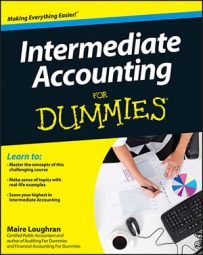What does intermediate accounting cover?
Intermediate accounting delves into the more complex, more challenging aspects of accounting practices. It covers topics and accounting situations that go beyond the basics, including the following:
-
Time value of money: Intermediate accounting involves advanced time value issues, such as deferred annuities and long-term bonds. Annuities are multiple payments over a period of time that you either make or receive. Deferred annuities are a type of annuity contract that delays payments to the investor until the investor elects to receive them. Long-terms bonds are bonds a business holds in another company that extends out more than twelve months into the future.
-
Accounting for retail inventory: Inventory cost-flow assumptions, which are how the cost of inventory expenses on the income statement, are a big topic in financial accounting. An interesting expansion on this topic in intermediate accounting is accounting for retail inventory.
The retail inventory method uses a cost ratio to convert the ending inventory valued at retail to cost. Basically, this works by taking goods available for sale at cost and dividing them by goods available for sale at retail. You can then multiply sales by the resulting percentage to come up with ending inventory at cost.
-
Accounting for property, plant, and equipment: Intermediate accounting gets into the nitty-gritty of accounting for an involuntary conversions such as theft. When this happens, a company has to record the difference between insurance proceeds and the asset’s net book value as gain or loss on disposal of asset.
-
Research and development expenses (R&D): This thorny topic is rarely discussed in your financial accounting class. Intermediate accounting shows you how to handle the costs of R&D, such as when a drug company is developing a product to bring to market.
-
Accounting for income taxes: No one likes income taxes, and your financial accounting textbook discusses this topic minimally. Intermediate accounting to the rescue! Intermediate accounting covers how to calculate the difference between financial and tax accounting. A major difference between the two is financial and tax depreciation. Financial depreciation takes the long-way home while tax depreciation takes the short cut through the vacant lot! So net income between the two will differ.
Important differences between US and international accounting standards
Your intermediate accounting textbook homes in on generally accepted accounting principles (GAAP) in the United States, but, where applicable, points out international perspectives for accounting for the same events. Both positions are noted because GAAP and international accounting standards are on the road toward convergence, and one set of global accounting standards could evolve.. Here are some key differences between U.S. and international accounting standards:
-
Extraordinary items: These items are unusual in nature and infrequent in occurrence. An example could be losses resulting from a major casualty such as a fire. US GAAP allows special financial reporting for these types of events while international standards do not.
-
Accounting for leases: Whether a company expenses lease payments or treats them like loan payments divvying up the payment between principle and interest under US GAAP depends on GAAP capitalization rules. International standards are more user-friendly, and look at the basic facts and circumstances of the lease to determine whether lease payments are expensed or capitalized.
-
Tax deferrals: Deferrals arise on the balance sheet because of the difference between financial and tax income. US GAAP allows for the classification of the deferrals as current or non-current, depending on the situation. International standards only allows for non-current treatment of these deferrals.
-
Balance sheet preparation: It’s Financial Accounting 101 knowledge that current accounts show up on the balance sheet before non-current ones. For example, current assets like cash list before property, plant, and equipment. However, companies using international standards often list non-current liabilities before current ones.
-
Monetary assumptions: US GAAP ignores the effect of inflation and deflation for accounting measurement and analysis. Using international accounting standards, countries with persistent inflation will general a price-index to adjust for inflation’s effect on their financial reporting.

